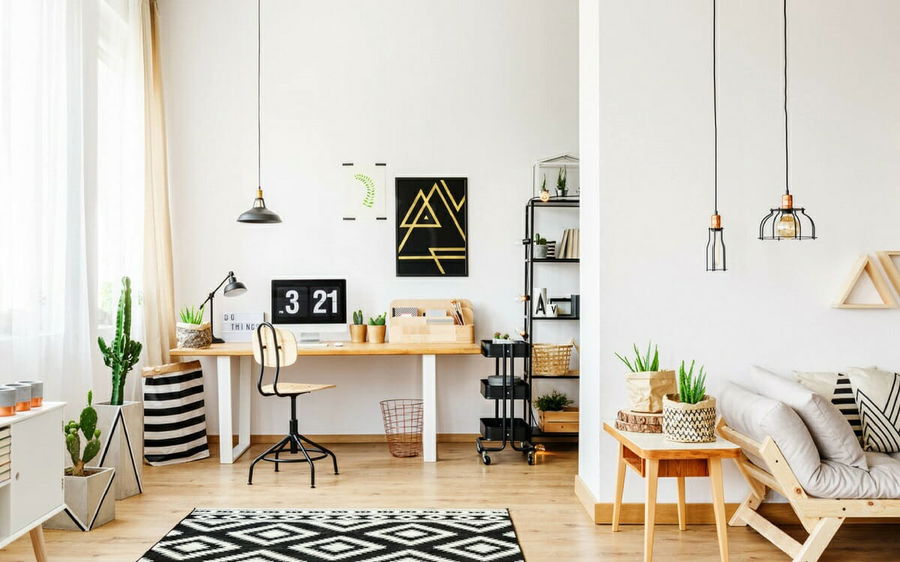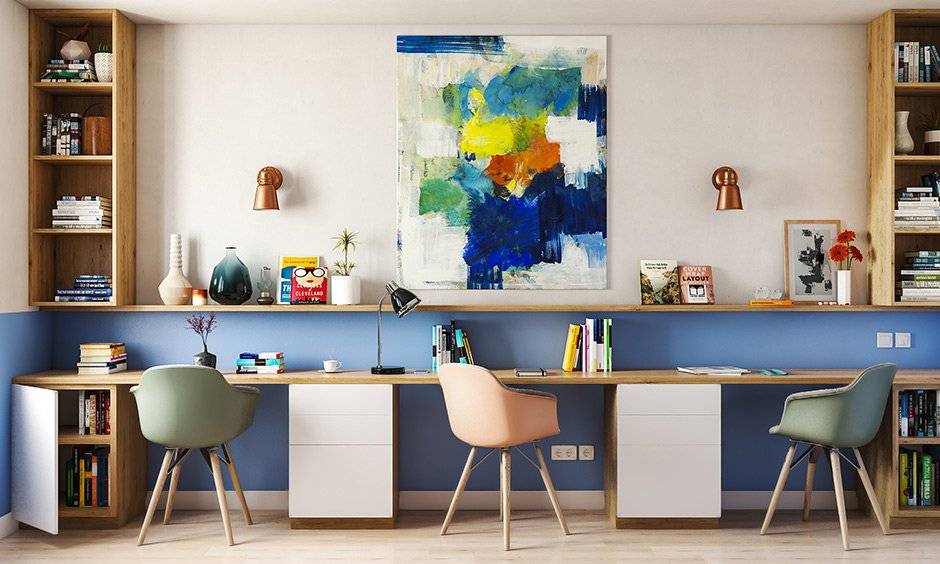Blog
Top Study Room Designs for Students and Professionals
A well-designed study room is essential for maximizing focus, productivity, and comfort. Whether you’re a student cramming for exams or a professional working from home, the layout and design of your study room can significantly impact your ability to work efficiently and comfortably. From practical layouts to aesthetic touches, here are some top study room designs that cater to the needs of both students and professionals, helping to create a productive, inspiring, and organized space.

1. Minimalist Study Room Design
A minimalist study room design focuses on simplicity and functionality, promoting a clutter-free and stress-free environment. This design is ideal for those who prefer a clean, organized space that minimizes distractions.
- Clean Lines & Neutral Colors: Stick to neutral tones like whites, grays, and beiges for the walls, furniture, and decor. These calming colors create a peaceful atmosphere that encourages focus and concentration.
- Functional Furniture: Choose sleek, modern furniture with minimal design elements. A simple desk, ergonomic chair, and a few well-placed shelves for books and stationery will keep your study area functional yet uncluttered.
- Decluttered Workspace: Keep only essential items on your desk to avoid distractions. Use wall-mounted shelves or under-desk drawers for storage to maintain a tidy and efficient space.
- Ambient Lighting: Opt for soft, ambient lighting to create a relaxing environment. A modern desk lamp with adjustable brightness ensures that you have the right light for reading and writing without causing eye strain.
2. Industrial Study Room Design
An industrial study room design is perfect for individuals who appreciate a raw, urban aesthetic with a focus on practicality. This design features exposed materials, functional furniture, and a cozy yet edgy vibe.
- Exposed Brick and Metal Elements: Incorporate raw materials like brick walls, metal light fixtures, and steel shelves. This gives the room a modern, industrial feel that’s both stylish and functional.
- Wooden and Metal Furniture: Combine wood and metal for a sturdy, industrial look. A metal-framed desk with a reclaimed wood surface can add character, while an industrial-style chair ensures comfort during long hours of study or work.
- Large Windows for Natural Light: Industrial rooms often feature large windows, allowing plenty of natural light to flood the space. If this isn’t possible, use industrial-style floor lamps or pendant lights to brighten the room.
- Open Shelving: Open shelving is a hallmark of industrial design, offering easy access to books, files, and study materials. Keep items organized by using baskets or boxes to avoid clutter.
3. Cozy Study Room with Soft Textures
A cozy study room design is ideal for those who prefer a warm and inviting space that promotes relaxation as well as focus. Soft textures, warm colors, and comfortable furniture create an environment where you can study for hours without feeling stressed or uncomfortable.
- Warm Tones and Textures: Use soft, warm colors like deep oranges, browns, or soft yellows to create a comforting atmosphere. Layer plush rugs, throw pillows, and blankets to make the room feel homier.
- Comfortable Seating: Invest in a comfortable chair or even a small sofa where you can relax during breaks. A cushioned armchair can also serve as a cozy spot for reading or brainstorming.
- Soft Lighting: Soft, warm lighting is key to this design. Use table lamps, floor lamps, or fairy lights to create a soothing glow. Adjustable lighting is also essential for reducing eye strain during study sessions.
- Personal Touches: Personalize your study space with family photos, artwork, and meaningful decor items. These personal touches make the space feel more comfortable and motivating.
4. Modern and Sleek Study Room Design
A modern study room design incorporates clean lines, minimalist furniture, and contemporary decor to create a stylish and functional workspace. This design suits professionals or students who appreciate a more sophisticated, yet functional, environment.
- Sleek Furniture: Choose modern, streamlined furniture with minimalist designs. A simple, modern desk, an ergonomic chair, and clean lines in your shelving and storage solutions contribute to a professional look.
- Neutral and Bold Color Scheme: A modern study room often uses a neutral color base with pops of bold colors, like navy blue, emerald green, or mustard yellow, to add visual interest. Consider incorporating these colors through accent walls, artwork, or decor.
- Innovative Lighting Solutions: Incorporate sleek lighting fixtures like a statement pendant light, desk lamps with a minimalist design, or a modern chandelier. Consider smart lighting solutions that allow you to adjust the brightness and color temperature for different tasks.
- Storage Integration: Choose furniture with built-in storage, like desks with drawers or floating shelves, to keep your study materials organized and out of sight.
5. Nature-Inspired Study Room Design
A nature-inspired study room design incorporates natural elements to create a peaceful, refreshing environment that promotes focus and well-being. This design is ideal for individuals who appreciate the calming influence of nature.
- Indoor Plants: Add a variety of indoor plants to your study space. Not only do plants improve air quality, but they also create a calming environment that boosts productivity. Consider low-maintenance plants like succulents, snake plants, or pothos.
- Natural Materials: Use natural materials such as wood, stone, or bamboo for your furniture and decor. A wooden desk and chairs, bamboo shelving, or a stone vase can enhance the organic feel of the room.
- Soft Green and Earthy Colors: Incorporate soft green tones or earthy neutrals like taupe and beige for the walls and furniture. These colors evoke a sense of tranquility and connection to nature.
- Natural Light and Soft Lighting: Maximize natural light by positioning your desk near windows. If natural light is limited, use warm, soft lighting like lamps with wooden bases or diffused pendant lights to maintain a cozy, nature-inspired atmosphere.
6. Functional Study Room for Small Spaces
If you have limited space, it’s essential to design a study room that maximizes functionality while maintaining a comfortable atmosphere. Small space designs focus on utilizing every inch of available space for storage and functionality without sacrificing style.
- Compact Furniture: Opt for space-saving furniture such as a fold-out desk, wall-mounted shelves, or a corner desk. A floating desk or wall-mounted desk can also create more room for movement in the study area.
- Vertical Storage: Use vertical storage options like tall bookshelves, wall-mounted organizers, or floating shelves to keep study materials organized without taking up floor space.
- Multipurpose Furniture: Consider multifunctional furniture like a desk that doubles as a bookshelf or a chair with built-in storage. This helps you make the most of your limited space.
- Light and Bright Color Scheme: Lighter colors like white, light gray, or soft pastels can make a small study room feel larger and more open. Combine this with mirrors or reflective surfaces to visually expand the space.
7. Professional Home Office Design
For professionals working from home, a study room or home office needs to be both functional and aesthetically pleasing, combining productivity with style. This design focuses on creating a space that supports long hours of work, video calls, and meetings.
- Ergonomic Furniture: An ergonomic desk and chair are essential for maintaining comfort during long working hours. Choose furniture that promotes good posture and provides ample storage space for documents, electronics, and supplies.
- Separate Work Zones: If you have a larger space, consider creating distinct areas for different tasks, such as a desk for focused work and a small seating area for meetings or breaks.
- Business-Ready Decor: Opt for professional decor like framed artwork, modern shelves, and a neutral color palette. Choose decor that reflects your style while maintaining a sophisticated, business-like atmosphere.
- Adequate Lighting: Good lighting is crucial in a home office. Combine overhead lighting with a desk lamp that provides task lighting for detailed work. Consider adjustable lights to control the ambiance based on the time of day.
8. Tech-Savvy Study Room Design
For students or professionals who rely heavily on technology, a tech-savvy study room design integrates modern gadgets, smart features, and efficient organization to create an optimal workspace.
- Tech-Integrated Furniture: Look for desks with built-in charging ports, cable management solutions, and wireless charging stations. This keeps your devices charged and organized without visible cords.
- Multiple Screens: If your work involves multitasking or research, consider using dual monitors or a large screen setup to increase efficiency. Position them at eye level to reduce neck strain.
- Smart Lighting: Use smart bulbs or adjustable desk lamps that allow you to control brightness and color temperature with ease, depending on the task at hand.
- Organization for Gadgets: Incorporate cable management systems, storage trays, or drawer organizers to keep your tech gadgets, cables, and accessories neatly arranged.

Conclusion
A well-designed study room can significantly improve productivity, focus, and comfort for both students and professionals. Whether you prefer a minimalist, industrial, or nature-inspired design, it’s important to create a space that reflects your personality and supports your needs. By considering furniture, lighting, color schemes, and layout, you can craft a study room that is both functional and inspiring, allowing you to work efficiently and stay motivated.


